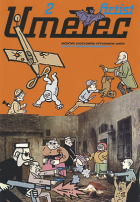| Umělec magazine 1997/2 >> A Quiet Scandalist in Moscow | List of all editions. | ||||||||||||
|
|||||||||||||
A Quiet Scandalist in MoscowUmělec magazine 1997/201.02.1997 Jana Žiljajeva | moscowe | en cs |
|||||||||||||
|
What we call art today is everything that shows the ability to present as art that what is not art. If you understand this simple formula, you can set out to Moscow galleries with no fear. The luckiest moment is when you happen to be a witness of a performance. It is not completely out of question that the artist would try to get the audience involved in his or her conceptual act. After symbolic feet washing, Alexander Brenner once took the bucket with hot water and threw it into the audience fortunately breaking only a window. Oleg Kulik bit a Swedish diplomat. When her husband tried to help her out of this situation, the artist tear his pants into pieces. Andrey Velikanov set on fire a cake at the U.S. Embassy stumping on it with his feet. The cake was meant to be eaten as a piety for the victims of the nuclear bombing of Hiroshima. Members of the Absolute Love sect sew each other´s lips, play chess with burning pieces holding them with their bare hands. True, they leave the audience out of this ...
Young Moscow-based artist Alena Martynova decided to stir the sexist atmosphere of the city´s non-conformists. After one of her performances at the TV Gallery, the Moscow audience burst out in rage. The show was called The Technique of A Radical Gesture and consisted in the artist shaving her croch. The hip Ptyuch magazine called her one of the brightest women of the past year. In her art, Alena Martynova is a hooligan - sort of like Alexander Brenner or Oleg Kulig in a skirt. In her real life, however, she is a quiet icon restorer, a housewife and a loving wife. “The main character of Parker´s The Wall is shaving his eyebrows and chest. By doing this, he is destroying himself, he is coming to terms with himself. To this sad gesture I´m adding sequences of shaving a woman´s croch. It is quite common for people today to alter their appearance. Is shaving croch too openly feminist? Why, millions of women around the world - epecially Muslim women - shave all the hair on their bodies. Initially it is a blasphemic gesture as shaving a croch is interfering with female beauty. While blasphemic, it does not have to bear any social significance. For me, shaving my croch is only a rutine act just like applying paint on canvas which I´ve been involved with for a long time. Who can deny that shaving a croch is perfectly the same artistic activity as painting?“ (page 16)
01.02.1997
Recommended articles
|
|||||||||||||







Comments
There are currently no comments.Add new comment